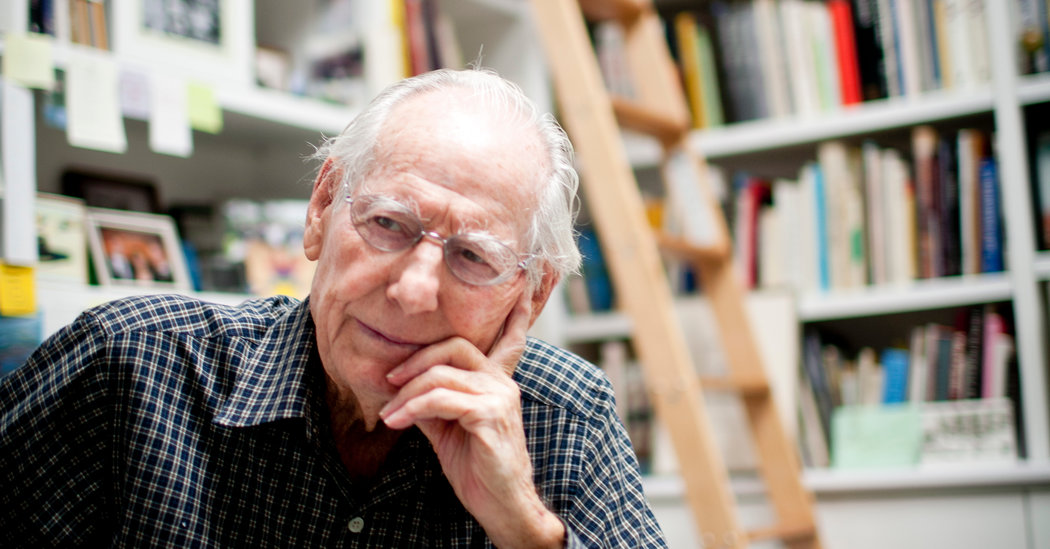

Wayne Thiebaud, the California-based painter whose lush, dreamy landscapes and luminous pictures of hot dogs, deli counters, marching band majorettes and other charmed relics of midcentury Americana were complex meditations on life and painting, and represented one of the most affecting and individual variations on 20th-century Pop Art, died on Saturday at his home in Sacramento. He was 101.
His death was confirmed by his gallery, Acquavella.
Truth be told, Mr. Thiebaud was not really a Pop painter. Detractors sometimes tried to pigeonhole him as one or as an illustrator. In fact, like many of the historical artists he admired, he was a virtuoso of the everyday and its deep, subtle symbolism.
In person he was a classic of the old American West, a slender man of Gary Cooperish charm and dry humor — soft-spoken, modest, layered, self-assured. Often bathed in Pacific sunshine, Mr. Thiebaud’s art looked at first flush radiant and plain as day. But on closer inspection, his pictures of idealized pies, spaghetti entanglements of highways and gumball machines rimmed in blue halos required unpacking. A rustling of unexpected sadness occasionally crept into the paintings after that initial leaping rush of joy — an unsentimental nostalgia for a bygone era or some long lost love.
A lifelong teacher, Mr. Thiebaud grounded his art in slow, hard-earned craftsmanship. This approach linked him to past Americans like Thomas Eakins and John James Audubon and to Europeans he admired like Jean-Siméon Chardin and Giorgio Morandi, whose images were also held together by the strictest geometry.
That said, Mr. Thiebaud’s pictures were the opposite of mechanical-looking, their slathered surfaces as rich and thick as the icing on his painted layer cakes. This tactile luxuriousness was one of the things that separated him from classic Pop painting.
Like Philip Pearlstein, Alfred Leslie and Alex Katz, who emerged, as he did, during the early 1960s, Mr. Thiebaud evolved a distinctly deadpan style of figuration. Endearing and typically alone, the people in his paintings could bring to mind Willy Lomans in ill-fitting business suits hunched over paperbacks, and Twiggy look-alikes in yellow dresses and groovy white boots. They were portraits with the whiff of faded Polaroids.
The effect, Mr. Thiebaud once said, was meant to be like seeing a stranger “in some place like an air terminal for the first time: you look at him, you notice his shoes, his suit, the pin in his lapel but you don’t have any particular feelings about him.”
Wayne Thiebaud (pronounced T-bow) was born on Nov. 15, 1920, in Mesa, Ariz. His maternal grandmother was one of the original Mormon settlers in Utah during the mid-19th century. An inventor, his father moved the family to Long Beach, Calif., when Wayne was a baby. With the Depression the family moved back to Utah to take up farming.
Mr. Thiebaud described spending his childhood milking cows, shooting deer for meat and planting alfalfa. His uncle, Jess, an amateur cartoonist, would amuse him by drawing; he attributed that experience, along with reading cartoons, to his early interest in art.
He would later give up on Mormonism, and on farming and life in Utah, but the scenery stayed with him. In later years, Mr. Thiebaud painted incandescent, slightly antic landscapes, almost abstract grids of imaginary fields and rivers seen as if from a bird’s perspective. These were based on memories from childhood, filtered through the study of Chinese painting and Monet, then mashed up with real views of the Sacramento Valley, where Mr. Thiebaud eventually settled.
Poetic scenes, ingeniously colored, they could appear as complex as his pies looked straightforward. In pictures like these, Mr. Thiebaud became a purveyor not just of Western sights, but also of Western light, Western silences and Western spaces.
He studied commercial art in high school, wrangled odd jobs as a sign painter and cartoonist, worked briefly as an apprentice animator at the Disney studios (as a lark, he had trained himself to draw Popeye with both hands at the same time, which helped him get the gig), and devised movie poster illustrations.
In the Army during World War II he worked as an illustrator for an Air Corps newspaper, then landed a job after the war drawing a comic strip for an in-house magazine of the Rexall Drug Company in Los Angeles, where a co-worker, Robert Mallery, encouraged him to think seriously about painting as a career.
So he did.
He began by painting expressionistic pictures, a little like John Marin’s, with an eye toward the New York School, which was then in vogue. But he never lost respect for commercial art, and in this early work he sought to marry the skills and shorthand ingenuity commercial art required with the freedom that expressionism entailed.
He would ultimately owe debts to Krazy Kat and Mickey Mouse, to Edward Hopper and Joaquín Sorolla, the turn-of-the-century Spanish academic painter, as well as to Willem de Kooning, the New York School paragon, whom Mr. Thiebaud met during the 1950s while living briefly in New York.
He would later say he particularly admired how de Kooning had found a way to “light a picture from within.” It was part of Mr. Thiebaud’s genius, as The New Yorker magazine writer Adam Gopnik once observed, to extract from such a different artist what became an essential quality of his own work.
By the early 1960s, while exhibiting at the Allan Stone Gallery in New York, Mr. Thiebaud had produced paintings like “Four Pinball Machines,” “Bakery Counter” and “Cakes.” Instantly grouped with the rising Pop movement, he achieved quick fame, but at heart shared little of Pop’s kneejerk penchant for consumerist satire. To Mr. Thiebaud, the humble objects and everyday people and friends he painted were touching and deserved respect. Like him, they remained true to themselves, a quality his art celebrated.
He also, and for good reason, came to be linked with Bay Area Figuratives like David Park and Richard Diebenkorn, playing a large role in the evolution of the California art scene during the 1960s, ’70s and ’80s. The Bay Area during these years, before the tech revolution, was a thriving and independent art center, and Mr. Thiebaud embodied its best characteristics.
Among those was a low-key, playful, healthy distance maintained from the hothouse art world back east, with its moneyed, myopic obsessions, self-importance and shibboleths. Mr. Thiebaud poked fun at that world from time to time. A painting of a drawer of neckties became a mock Morris Louis; a picture of scattered crayons spoofed Richard Serra. The humor deflated pretense, which Mr. Thiebaud in person entirely lacked.
A longtime professor at the University of California, Davis, Mr. Thiebaud counted very different artists like Bruce Nauman among his progeny. As his work came to trade for increasingly astronomical sums, he became a patron of the university’s museum. Throughout his later decades, major museums regularly staged exhibitions of his work.
Among them, in 2018 the Morgan Library in New York presented “Wayne Thiebaud: Draftsman,” a survey of his works on paper. By that time, Mr. Thiebaud was 97. His second wife, Betty Jean, a filmmaker, had died in 2015. In 2010, his son, Paul, who ran the Paul Thiebaud Gallery in San Francisco and New York, died of cancer.
Two daughters, Twinka Thiebaud and Mallary Ann Thiebaud, from his first marriage to Patricia Patterson, survive him, as does his son Matt Bult, from his second marriage, and six grandchildren.
During his last years, he continued to play an improbably deft and crafty game of tennis and to paint. At 100, he was still out on the court, occasionally calling friends, working on new themes: he had met some clowns when he was a boy hawking newspapers to customers attending the circus, he said. The memory of those encounters stuck with him.
“It has never ceased to thrill and amaze me,” he said, “the magic of what happens when you put one bit of paint next to another.
“I wake up every morning and paint,” he added. “I’ll be damned but I just can’t stop.”
